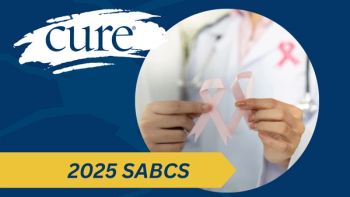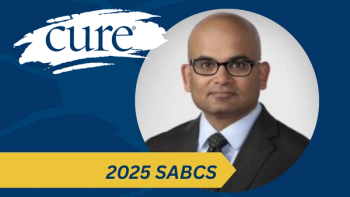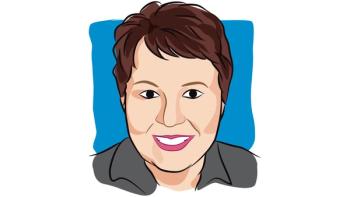
- Hematology Special Issue (February) 2021
- Volume 1
- Issue 1
A ‘T-ALL’ Order: Treating T-Cell Acute Lymphoblastic Leukemia
Oncologists and researchers are racing to identify new therapies to help better treat a rare form of acute lymphoblastic leukemia.
Keith Owens had no time to be sick.
He and his wife were driving home from a late July wedding in 2019 when it really began to hit
him. Back in Rochester, New York, he collapsed, and then endured three days of chest pains, a terrible cough and night sweats. He barely left his bed. “Everything started to seem a little bit harder to me,” he says. “I’ve always kind of overexerted myself with everything I do. Just thought I was overworking myself.”
Owens’ wife, Allison, was eight months pregnant. Like many other 31-year-olds, Owens didn’t even have a doctor. But once Allison dragged him to urgent care, things escalated quickly. His blood pressure was through the roof. Another doctor suspected thyroid issues and ordered imaging, which revealed a 6-inch mass in his chest. Owens headed to the hospital for bloodwork and didn’t check out for a month.
For many cancers, diagnosis unfolds at what feels like a glacial pace. Weeks elapse between appointments. There’s ample opportunity for research, worry and second opinions. But T-cell acute lymphoblastic leukemia (T-ALL) hits like a landslide.
“In most instances, it is a very urgent situation where we need to hospitalize people and get them going on treatment,” says Dr. Mark Litzow, head of the acute leukemia group at Mayo Clinic in Rochester, Minnesota.
“All these procedures are coming at them,” says Owens’ oncologist, Dr. Kristen O’Dwyer. She’s clinical director of the acute leukemia program of the Wilmot Cancer Institute at the University of Rochester Medical Center in New York. “I have to do a bone marrow biopsy, get a central line and a lumbar puncture, an echocardiogram. If it’s a young man, there’s fertility preservation. All these things in a matter of 48 hours, so I can get them starting on treatment. And they have to trust me,” O’Dwyer adds, “which is huge, especially for a young patient who is like, ‘I don’t have cancer. I’ve just been really tired because work has been crazy.’”
Cure Rates Decline as Patients Get Older
Acute lymphoblastic leukemia (ALL) — sometimes known as acute lymphocytic leukemia — is an aggressive cancer of the blood and bone marrow. “Our bone marrow produces many billions of cells every day,” says Litzow. Stem cells in the marrow produce immature cells called blasts that, when healthy, will develop into one of many different blood cells. In this constant state of division, mistakes happen. Biological safety mechanisms catch most of these, but sometimes abnormal cells escape and take over. “Instead of maturing and producing red blood cells, white blood cells and platelets, it just keeps making more of itself,” Litzow says.
Most ALL (85%) derives from defects in B lymphocytes, cells that normally mature into the antibody-producing white cells that help fight off infection. Cure rates for B-ALL are high and getting higher. T-ALL arises from T lymphocytes, which are important cells in the immune system for fighting infections and other immune functions.
The most common childhood cancer, ALL also afflicts adults. T-ALL is a subset of ALL and is a rare cancer: An estimated 6,150 new cases of ALL were diagnosed in 2020 in the United States; just 25% of these cases were in adults with T-ALL. It’s largely a disease of adolescents and young adults (aged 15 to 39). Although incidence diminishes with age, it’s a trade-off: Cure rates for children are high and decline as patients get older.
In young children, certain genetic mutations found in B-ALL tend toward good outcomes. In teenagers, these “good” mutations decline and high-risk elements gain. “By the time you’re looking at young adults, you very rarely see the good-risk genetic subtypes,” says Dr. Stephen Hunger, director of the Center for Childhood Cancer Research at the Children’s Hospital of Philadelphia. “The high-risk genetic subtypes are much more common.”
Treatments began to emerge for ALL in the late 1960s. When some patients recovered from early-generation chemotherapy regimens and others did not, doctors learned from the differences. Children, for example, did better than adults. In the 1970s it became possible
to distinguish between ALL from B lymphocytes and T lymphocytes. The more common B-ALL responded well to therapy, while patients with T-ALL fared much worse.
Treatment for B-ALL delivered on this promise and has reached exceptional levels thanks to new antibody therapy and CAR-T cell therapy. Treatments for T-ALL have not kept pace, though in the past few years improvements have led to cure rates approaching 90% in children and 70% in young adults.
ALL treatments are relatively similar, with one big difference: If the first line of treatment fails, backup for T-ALL is very limited, with Arranon (nelarabine) being administered with mixed results in patients. “For patients who do not achieve remission, or (who) relapse after achieving remission, it is nearly impossible to find an effective treatment,” says O’Dwyer.
Two Schools of Thought
T-ALL treatment regimens are difficult and complex, and adapted to a patient’s individual risk. Patients with a better prognosis need less intensive therapy, while those with less favorable prospects require more intensive treatments. “We’re trying to get a balance between avoiding toxicity and maximizing cure rates,” Hunger explains.
For T-ALL, the therapeutic regimens may include a half dozen or more drugs. Many of these specifically target the cancer — cyclophosphamide, vincristine sulfate, Adriamycin (doxorubicin), daunorubicin, cytarabine, mercaptopurine, thioguanine and Oncaspar (pegaspargase). Steroids like prednisone and dexamethasone are used liberally, as they are directly toxic to lymphocytes and therefore slow the disease and influence the immune system in useful ways. Other agents offer more immune modulation and help dampen side effects like neurotoxicity.
Some are given intravenously and others orally; a few are delivered both ways at different times. It’s often hyperfractionated, which means smaller doses are given at shorter intervals. Intrathecal therapy — fed into the spinal fluid via lumbar puncture — is used in all patients to prevent central nervous system relapse. Radiation is also possible for pockets of disease in places like the testicles where chemotherapy does not penetrate well.
A patient will typically experience many of these in a rotation of therapeutic cocktails that typically last 2.5 years. After diagnosis, there’s typically a monthlong hospital stay. Called induction, its goal is to hit the cancer hard and induce remission, while closely monitoring results.
How the cancer responds to treatment is pivotal, and the ultimate measure of patient response is called minimal residual disease (MRD). By taking a bone marrow sample and using high-tech scanners, it’s possible to detect minute levels of malignant blast cells. The more blast cells, the higher the risk of relapse. It’s an important metric, because how patients respond to the initial therapy is very predictive of the likelihood of successful treatment.
After induction, the next phase, known as consolidation, can last from eight months to more than a year. Some courses during this time are very intense — many consecutive days of treatment — while others are devoted to recovery. Some patients receive a stem cell transplant, a challenging round of treatment, immune isolation and recovery all by itself. The last year to 18 months is maintenance therapy, typically delivered orally.
Two different schools of practice have emerged for how to combine and sequence these treatments. They use similar ideas and ingredients, but are assembled in slightly different ways, as oncologists have strong preferences based on training and experience.
The two regimens go by the clumsy names hyper- CVAD and augmented Berlin-Frankfurt-Münster (aBFM). Because of the acute nature of T-ALL and the length of treatment, a patient’s treatment may be limited to the regimen practiced by their provider.
O’Dwyer says aBFM is common in most academic cancer centers. Hyper-CVAD, meanwhile, is more commonly used in community oncology, with the notable exception of The University of Texas MD Anderson Cancer Center in Houston. “They’re always doing a hyper-CVAD,” she says. “The results are, of course, excellent.”
But O’Dwyer has some opinions about the limits of hyper-CVAD in a community setting, where it is often used to treat both B-ALL and T-ALL, along with other blood cancers. Because T-ALL is rare, her concern is the lack of experience with some of the more complicated elements, like administering Oncaspar, an enzyme that breaks down a key amino acid fueling leukemia cell growth. It’s a difficult drug because of side effects — infusion reactions, severe toxicities, blood clots and pancreatitis. Experience helps guide safe use. “It’s such an important component for the cure of this disease that it’s really required,” she says.
Intrathecal therapy is also a challenge for those who don’t deliver it regularly. “We can get it done efficiently and quickly and safely. It’s harder to do that in the community,” O’Dwyer says. So that her patients can travel less, she partners with community oncologists for more straightforward aspects of treatment and handles the more complex elements in house.
“The plan should be developed in discussion with someone who does this a lot,” says O’Dwyer. “I think T-ALL is rare enough that, when at all possible, patients should be referred. It’s high stakes, upfront. You want to get it right the first time because you have so little salvage option.”
New Standard of Care
Emily Robbins was 22 when a lump in her neck knocked her world off track. In the previous few months, she’d run her first full marathon, had graduated from college and was barely into the second month of her first full-time job. Even as she was wheeled into the Wilmot Cancer Institute, she could not fathom the diagnosis. “I guess my body just didn’t want to hear that,” she says.
Robbins is not a child, but she has been treated as one — and that’s a good thing, because children tend to do better in ALL generally. Partly that’s due to favorable genetics, but partly it’s because they handle the difficult regimen better.
But as oncologists have gotten better at delivering their difficult medicine and managing side effects, they’ve pushed the treatment limits to extend pediatric treatment to adults. Results of a rigorous trial consisting of 295 patients, ranging in age from 17 to 39 years, were published in 2019. Only 3% of patients died of treatment-related causes, and only two patients died after remission. Just
as important, the amount of time before complications occurred almost doubled, to 6.5 years.
This new standard of care, which is also a new framework for future research, had been reported in a national meeting shortly before Robbins got sick and was the model for her treatment. But it’s not child’s play. The first month of hospital-based treatment was rough, though not in the same way as she had imagined. “I slept almost all day,” she says. “What was really hard was how weak my body got.” Because of the length of the treatment, she says, the side effects and the drugs that caused them all blend together for her.
While many children go back to school during the maintenance phase and resume a normal life, the oral chemo caused nausea for Robbins. She tried to return to work, but it didn’t go well. She was still tired and had lots of side effects. “I pushed myself too hard,” she says. “My advice would be just to give yourself a break.”
The length of treatment really defines the experience. “I don’t know what normal is,” she says. “I don’t remember. I can’t compare my life to what normal was for me. I can’t imagine anyone younger going through it. Thinking of someone young having to get that kind of intense treatment is just scary to think about.”
“We’ve done a lot to improve cure rates for T-ALL, which is very rewarding,” says Hunger. “But you know, it’s still pretty nasty treatment that you wouldn’t wish on your worst enemy. The upper age limit for who will tolerate those regimens is a bit of a moving target. Certainly, at the age of 40, we definitely would consider — unless somebody had a lot of other medical problems — giving a pediatric- intensive regimen.” But as T-ALL occurs in patients past their 50s, the outcomes decline. They have higher-risk disease, don’t tolerate the aggressive treatment as well and have a higher risk of complications.
Potential Developments
For many cancers, the enormous strides in the ability to read genetic code have unlocked a range of new therapies. However, those targets have led to a dead end. “They haven’t translated into clinical use at all,” says O’Dwyer.
Indeed, the latest improvement comes from Arranon, a drug first conceived of in the 1950s, then brought to fruition in the 1970s. Arranon inserts itself into T-cell DNA when it gets copied. The error triggers cellular self- destruction. It was first approved in 2005 for patients who had failed two rounds of conventional treatment.
But Arranon has serious and sometimes fatal neurologic toxicities. “It was a hard drug to move forward,” says Hunger, who was involved in the clinical trials. “We had to go through nearly a decade of studies just to first prove to ourselves and everybody else that it was safe to give
to patients.” Eighty percent to 85% of patients are cured without it and 85% to 90% are cured with it. “Clearly it improves the overall outcome, but only marginally, which is most of what we’re looking at these days,” he says. “These advances take place because patients decide to trust physicians and enroll in clinical trials to test new therapies. It’s a partnership between patients and physicians.”
CAR-T cell therapy, the much-heralded new immunotherapy, has provided unprecedented remission rates for patients with B-ALL. T-ALL has been more puzzling because the therapy manipulates the very same T cells that go haywire. With the cancer intimately entangled in the biology of the cure, wires get crossed, and the wrong T cells get killed. Scientists are working on solutions, and O’Dwyer expects a lot more patients to be treated for T-cell malignancies at various research hospitals this year.
Despite the promise of CAR-T cell therapies, the next round of trials toward incremental improvement in standard therapy is being shaped now, building off the Arranon-enhanced pediatric regimen.
Among the agents on the near horizon are Velcade (bortezomib), Darzalex (daratumumab) and a tag team of Venclexta (venetoclax) and navitoclax. Velcade is already used to treat multiple myeloma and mantle cell lymphoma, and other blood cancers. Like many chemotherapy agents, Velcade triggers natural self-destruct sequences common to all cells.
Darzalex is also used in the treatment of multiple myeloma and several rare lymphomas. It targets CD38, a protein common on T-ALL cells. Venclexta has already been approved for use in chronic lymphocytic leukemia.
O’Dwyer and her colleagues are hoping to test Darzalex and Venclexta/navitoclax in parallel, flipping patients from one treatment to the other depending on results. “We’ll get a lot of information based on those two approaches,” she says.
For more news on cancer updates, research and education, don’t forget to
Articles in this issue
almost 5 years ago
Team Efforts Propel Cancer Victoriesalmost 5 years ago
Treatment Advances Transform CML Into Chronic Diseasealmost 5 years ago
Knocking Out Chronic Myeloid Leukemia with Precisionalmost 5 years ago
Above the Surface: A Discussion About Cutaneous T-Cell Lymphomaalmost 5 years ago
Adding to the Regimen: NCCN Updates in Leukemia and Lymphomaalmost 5 years ago
Keep it Flowing: Combating COVID-19 Blood Shortages in Cancer Treatmentalmost 5 years ago
Managing Cancer Scares During a Pandemic



